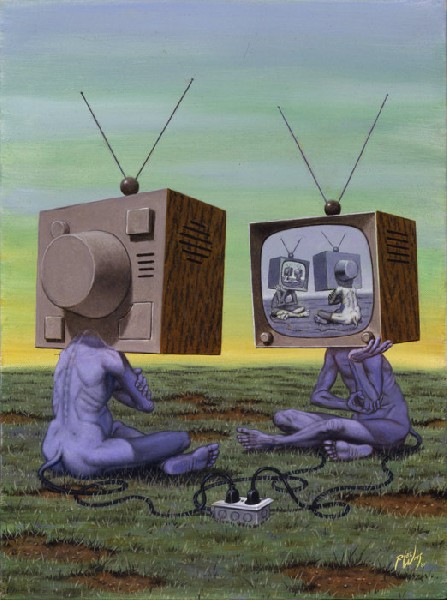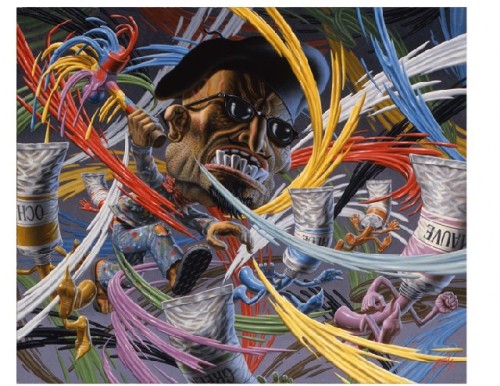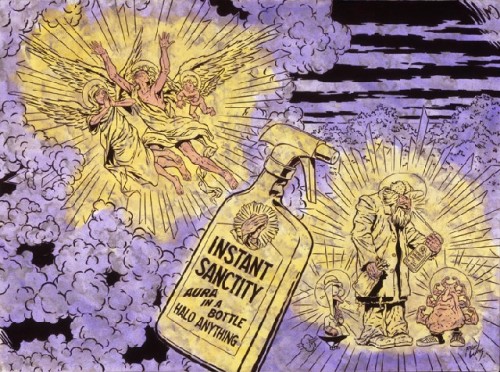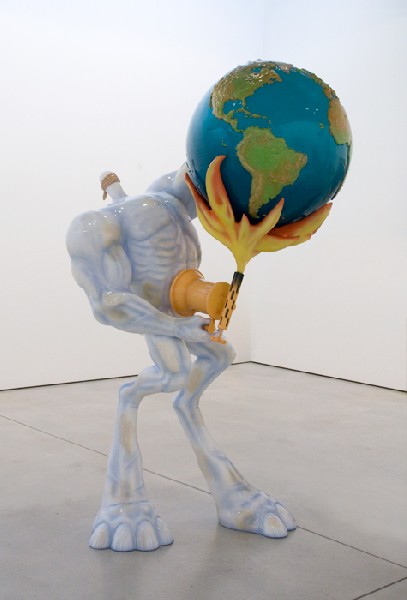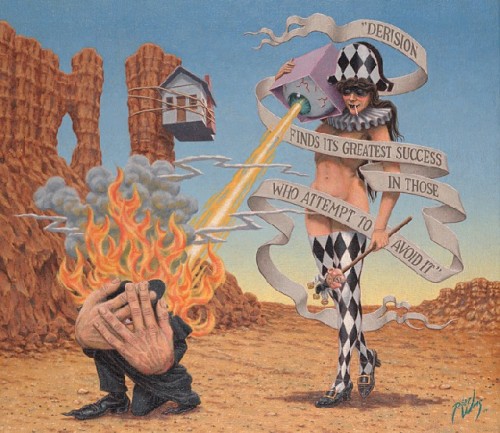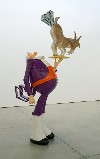Robert Williams: NY's Tony Shafrazi Gallery
Conceptual Realism, In the Service of the Hypothetical
By: Adam Zucker - Dec 02, 2009
Robert Williams:Conceptual Realism, In the Service of the Hypothetical
October 31, 2009 - January 23, 2010
Tony Shafrazi Gallery
544 West 26th Street
New York, NY
"We got nothing better to do than watch TV and have a couple of brews." Those are lyrics from TV Party by the 1980's West Coast hardcore punk band Black Flag. This song was blaring through the Tony Shafrazi gallery while I admired the painting "Symbiotic Mediocrity," where two TV-set-head characters sit idly in the mid-foreground of a barren landscape amongst a glazed over blue-green sky. The characters face each other and are programmed to replicate the images of themselves, like two mirrors adjacent to one another, reducing the figures to dormant ape like creatures with a parasitic host upon their heads (usually in the animal kingdom it is a pesky flea). I laughed out loud at once gazing at the picture and listening to the song juxtaposing one another. The choice to play this song (whether it was on shuffle and unintentional or planned) fit the context of Robert Williams' solo show almost perfectly.
In no way does Robert Williams' art suggest an ideology as bland as having nothing better to do, but it is a more progressive approach to the punk rock aesthetic of being fed up with the current state of affairs. For Robert Williams that condition began a decade earlier during the late 1960's when conceptual art in the form of minimalism and pop art, surpassed the prevailing mainstream mode of formalist and non-representational painting that was Abstract Expressionism. Williams was treading uncharted waters when he combined the age-old aesthetic of realism with the conceptual ideologies of pop art and the absurdities of surrealism. He created a style of fine art painting that was soaked with cartoon and comic book imagery. He even gave the first series of paintings the name "Lowbrow," which was a stab at the art world's obsession with putting academic and intellectualism on fine art. The art schools were all teaching formalism and for talented draftsmen like R. Crumb, Ed "Big Daddy" Roth, and Robert Williams, there was no place for "illustrators" amongst the hierarchy. Critics like Clement Greenberg who advocated the abstraction of Pollock, De Kooning and Reinhartd helped to implicate such an unfavorable view of figurative painting. However, Pollock and de Kooning both returned to painting recognizable imagery. It was of no surprise that Willem de Koonings' "Women" series, which used gestural handling of the paint and formalist compositional theory to create a recognizable image, drew sharp criticism from critics and even his own Ab Ex peers. In the catalog for Emotional Impact: New York School Figurative Expressionism, curator April Kingsley writes that at one particular meeting of the "Artists Club" Ad Reinhartd even went so far as to say that the only difference he saw between de Kooning and Norman Rockwell was that Rockwell had a higher opinion of women. For Robert Williams, whose figuration was far more realistically rendered than de Kooning, this wasn't a good sign of things to come.
However, Williams never took any formal artistic limitations as a setback. He made a more modest living designing hot-rods and illustrations for Ed "Big Daddy" Roth's "kustom kulture" shop in Southern California and contributed to the psychedelic counterculture of "underground comix." Towards the end of the exhibition along with sketches for the current work, we are treated to Williams' cover art for Zap Comix, the brainchild of another pop art conceptualist outsider named Robert Crumb. Williams' shift to fine art still has lingering qualities of the underground comix, but it is felt on a much more mystifying scale. By bringing these burlesque conceptual pictures into a gallery and shoving them into the very same faces that might have written them off as art previously, Williams has triumphed. He even gets the last laugh at those who might have ridiculed him through art school through the painting "The Ball-Peen Hammer Expressionist." In this painting a very angry "big-headed" bohemian looking artist chases running tubes of paint all over the canvas with a hammer. The result is convoluted splatters of paint affected by the artist bludgeoning the frantically scattering tubes.
Let it be known however, that we have the opportunity to cleanse our wicked judgmental ways of the past! We can do this with a bottle of "Instant Sanctity: aura in a bottle, halo anything!" This is depicted in the work "Instant Sanctity," which comments on the simplicity that instant prayer and confession have awarded to those who sin but don't chose to actually better themselves because all will be forgiven instantly through prayer. The drunk will keep drinking, and the creep will still be deviant. People will still hate, and many of us will continue to ignore the true problems of society. This is depicted by a large fiberglass sculpture called "Brute Waste." The piece illustrates a creature with an enormous body and a minuscule head holding a globe of the Earth in its left hand. With its right hand the creature holds a blowtorch to the globe's underbelly igniting the Earth and ignorantly speeding up climate change.
Will the institutionalized art world or members of "enlightened" society take kindly to such sharp criticism? No one is comfortable when they are scornfully exposed. It is therefore conceptualized in Williams' painting that "Derision Finds Its Greatest Success in Those Who Attempt to Avoid It."

